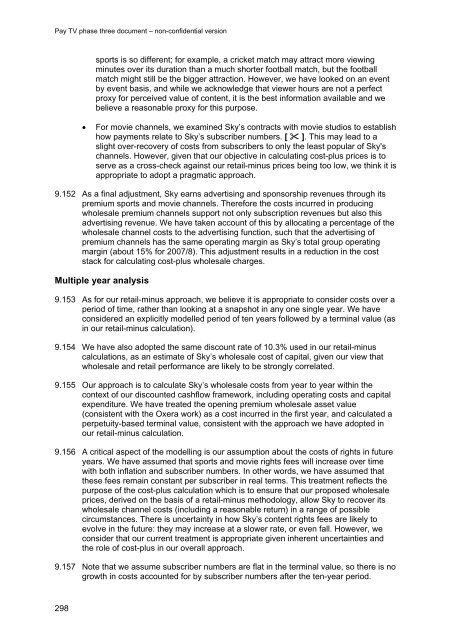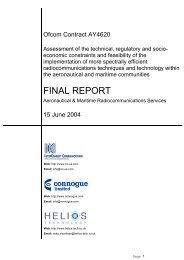Pay TV phase three document - Stakeholders - Ofcom
Pay TV phase three document - Stakeholders - Ofcom
Pay TV phase three document - Stakeholders - Ofcom
Create successful ePaper yourself
Turn your PDF publications into a flip-book with our unique Google optimized e-Paper software.
<strong>Pay</strong> <strong>TV</strong> <strong>phase</strong> <strong>three</strong> <strong>document</strong> – non-confidential version<br />
298<br />
sports is so different; for example, a cricket match may attract more viewing<br />
minutes over its duration than a much shorter football match, but the football<br />
match might still be the bigger attraction. However, we have looked on an event<br />
by event basis, and while we acknowledge that viewer hours are not a perfect<br />
proxy for perceived value of content, it is the best information available and we<br />
believe a reasonable proxy for this purpose.<br />
� For movie channels, we examined Sky’s contracts with movie studios to establish<br />
how payments relate to Sky’s subscriber numbers. [ � ]. This may lead to a<br />
slight over-recovery of costs from subscribers to only the least popular of Sky's<br />
channels. However, given that our objective in calculating cost-plus prices is to<br />
serve as a cross-check against our retail-minus prices being too low, we think it is<br />
appropriate to adopt a pragmatic approach.<br />
9.152 As a final adjustment, Sky earns advertising and sponsorship revenues through its<br />
premium sports and movie channels. Therefore the costs incurred in producing<br />
wholesale premium channels support not only subscription revenues but also this<br />
advertising revenue. We have taken account of this by allocating a percentage of the<br />
wholesale channel costs to the advertising function, such that the advertising of<br />
premium channels has the same operating margin as Sky’s total group operating<br />
margin (about 15% for 2007/8). This adjustment results in a reduction in the cost<br />
stack for calculating cost-plus wholesale charges.<br />
Multiple year analysis<br />
9.153 As for our retail-minus approach, we believe it is appropriate to consider costs over a<br />
period of time, rather than looking at a snapshot in any one single year. We have<br />
considered an explicitly modelled period of ten years followed by a terminal value (as<br />
in our retail-minus calculation).<br />
9.154 We have also adopted the same discount rate of 10.3% used in our retail-minus<br />
calculations, as an estimate of Sky’s wholesale cost of capital, given our view that<br />
wholesale and retail performance are likely to be strongly correlated.<br />
9.155 Our approach is to calculate Sky’s wholesale costs from year to year within the<br />
context of our discounted cashflow framework, including operating costs and capital<br />
expenditure. We have treated the opening premium wholesale asset value<br />
(consistent with the Oxera work) as a cost incurred in the first year, and calculated a<br />
perpetuity-based terminal value, consistent with the approach we have adopted in<br />
our retail-minus calculation.<br />
9.156 A critical aspect of the modelling is our assumption about the costs of rights in future<br />
years. We have assumed that sports and movie rights fees will increase over time<br />
with both inflation and subscriber numbers. In other words, we have assumed that<br />
these fees remain constant per subscriber in real terms. This treatment reflects the<br />
purpose of the cost-plus calculation which is to ensure that our proposed wholesale<br />
prices, derived on the basis of a retail-minus methodology, allow Sky to recover its<br />
wholesale channel costs (including a reasonable return) in a range of possible<br />
circumstances. There is uncertainty in how Sky’s content rights fees are likely to<br />
evolve in the future: they may increase at a slower rate, or even fall. However, we<br />
consider that our current treatment is appropriate given inherent uncertainties and<br />
the role of cost-plus in our overall approach.<br />
9.157 Note that we assume subscriber numbers are flat in the terminal value, so there is no<br />
growth in costs accounted for by subscriber numbers after the ten-year period.
















